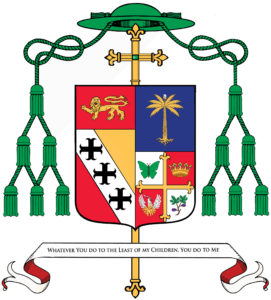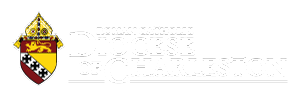
The Heraldic Achievement of Bishop Jacques Eric Fabre-Jeune, CS
or, the explanation of our bishop’s coat of arms
First, the coat of arms of the Diocese of Charleston is based on that of Pope Pius VII who established the See on 20 July 1820. Pius VII, a Benedictine monk, was a member of the Chiaramonti family, whose shield divided diagonally. The three Crosses Moline represent the Order of Saint Benedict (OSB). To honor the namesake of the See, King Charles II of England, a Golden Lion of this sovereign is displayed on a red chief. The use of this heraldic lion is also a play on the name of the founding bishop, John England, as the Golden Lion Passant Guardant on a red field, known as the “Lion of England.”
Bishop Jacques Eric Fabre-Jeune envisioned his personal coat of arms as a statement of faith and heritage, both of which have their beginnings in his birthplace, Port-au-Prince, the capital city of the Republic of Haiti. The overall colors of azure (blue), gules (red), and argent (silver) speak of life in Haiti and the United States.
Bishop Fabre-Jeune desired a coat of arms that would define clearly, simply, and humbly his heritage, his faith, his life and his ministry as a priest and as the shepherd for the Church in Charleston, South Carolina. The shield is divided in half as per the flag of Haiti.
The upper portion contains a Royal Palm Tree in gold with a Phrygian cap in gold and silver. The palm tree was the first and most important emblem requested by Bishop Fabre-Jeune. It is a symbol of his place of birth and heritage, plus a symbol of the faith so deeply rooted within the Fabre family. This particular palm tree has eight branches, one for each member of the Fabre family: Bishop Jacques, his parents Providence and Anita, and his five siblings. The strong roots of the Royal Palm Tree are clearly visible, reaching out to the tip of the Cross Fleury.
The lower half of the shield is subdivided quarterly, silver and red. The first quarter (upper left, silver) contains a green Butterfly, a symbol for migration. The island of Hispaniola is home to one of the species of this migratory monarch butterfly. The use of green is associated with new life.
The second quarter (upper right, red) features a Gold Crown borrowed from the coat of arms of the Scalabrinians — the Congregation of the Missionaries of St. Charles Borromeo — an international community of religious serving migrants and refugees of different cultures, religions and ethnicities. Bishop Fabre-Jeune is a professed member of this community.
The third quarter (lower left, red) contains a Phoenix rising from the flames: a mythical bird that rejuvenates itself by dying in fire and being reborn from the ashes, a symbol of eternal life. The phoenix is from the coat of arms of the city of Chicago, where Jacques Fabre-Jeune professed first vows as a Scalabrinian in 1982.
The fourth quarter (lower right, silver) contains a Fig Bough with Fruit, representing the Old Testament prophet Amos. Before responding to the call of the Lord, Amos was “a herdsman, and a dresser of sycamore-fig trees” (7:14).
The lower portion of the shield contains a Cross Fleury over all with a fleur-de-lis at the end of each arm. The fleur-de-lis represents a lily, which is commonly associated with the Virgin Mary. In the story of our salvation, Mary is the first of those called to serve the Lord. The use of the cross is also a nod to the first Bishop of Charleston, John England (1820-1842), whose coat of arms featured a Cross Bottony over all.
Above the shield is the episcopal cross of a bishop; it has one transverse arm. Bishop Fabre-Jeune chose a gold Cross Fleury thereby maintaining the French-Haitian aesthetic.
Surmounting the entire achievement is the galero or “hat of the pilgrim.” The galero is a heraldic emblem for prelates and priests of the Latin Rite of the Roman Catholic Church. The distinction of rank is defined by the color of the hat and the number of tassels. The galero of a bishop is shown in green with 12 tassels or fiocchi pendant, six suspended on each side.
The motto of Bishop Fabre-Jeune, “Whatever you do to the least of my children, you do to me,” is taken from Matthew 25:40. In Scripture, the love for God and love for people cannot be separated. We are commanded to see and serve God in those around us. The task is to do all things and render all service to all people for the love of God and for the sake of the Gospel.
Coat of Arms and Blazon by Dr. Geraldine M. Rohling.

